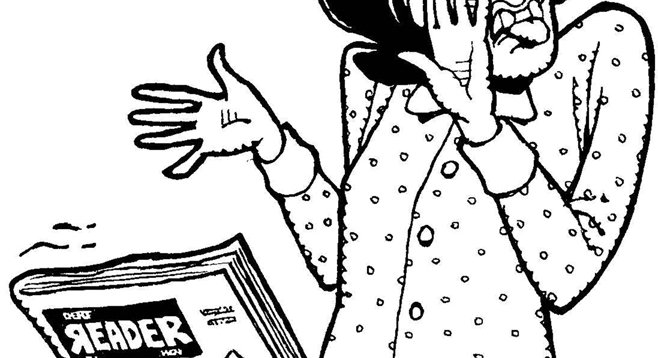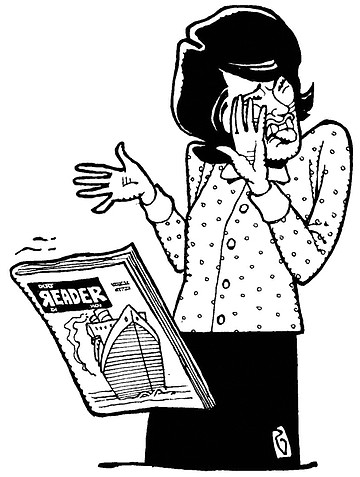 Facebook
Facebook
 X
X
 Instagram
Instagram
 TikTok
TikTok
 Youtube
Youtube

Heymatt,
Just last week a reader commented (complained) about the Reader’s back cover having pornographic advertisements of women’s clothing and apparel. To me, these ads were far from pornographic. In fact, there was zero nudity and it was a barely hinting notion of burlesque. Could you please elaborate on the difference between each term, as it seems that time and again people say one thing when meaning another.
— Tom

Yeah, well, if we could all agree on what’s egregious and what’s not, maybe Congress wouldn’t be such a rat’s nest. Imagine getting all of us to believe that the back-page coquette is merely fetching, not a flaming floozie. I guess I’ll get this out of the way right here, since everybody’s expecting it. Considered one of the most honest, straightforward, realistic, rational responses from any Supreme Court justice ever is that of Potter Stewart, back in the ’70s, I think, when deciding a pornography case. Frustrated with the court’s efforts to detail what’s pornographic, he threw up his hands and said, “I shall not attempt to further define the kinds of material I understand to be embraced within that shorthand description.... But I know it when I see it, and the motion picture involved in this case is not it.” Sometimes you just have to quit agonizing and make a decision. The concept of “I know it when I see it” has been autopsied in law journals ever since.
The dispassionate dictionary defines pornography as the depiction of erotic behavior intended to cause sexual excitement. From the Greek, porne + graphein, “writing about whores,” apparently a Greek pastime since they went to the trouble of inventing a word for it. Our Supreme Court has wrestled with the definition for decades. They base their decisions on the established concept of “obscenity,” things society considers disgusting, foul, immoral, and possibly blasphemous. I’m not sure how that clarifies anything, but... After thrashing around through a decade, several cases, and several slightly different definitions, the most comprehensive one came from Chief Justice Berger in 1977. His court said pornography must meet three criteria: (1) The work judged as a whole by the average person applying contemporary community standards, appeals to prurient interests. (2) The work depicts sexual conduct in a patently offensive way. (3) The work as a whole lacks serious literary, artistic, political, or scientific value. So, how many large trucks could one drive through that definition? Wiggle room (with heavy breathing) galore.
And we’re speaking here of hardcore porn as patently offensive and illegal. That concept goes way back in time. To Berger it refers to such things as “ultimate sex acts” (you’ll have to channel Berger to get clarification on that), masturbation, excretory functions, and lewd exhibition of genitals, all the things we know how to find on the internet. Softcore porn, the acceptable porn, involves depictions of nudity and brief simulated sexual conduct. This material is protected by the First Amendment because it is not graphic or explicit. That “freedom of speech” defense has extremely limited success with the courts in these matters.
So, there’s pornography in a nutshell. (Is a nutshell porn?) If, like me, you really don’t see how that helps us define it, especially in the hair-splitting, noun-tweaking, verb-bending world of the law, then we all can agree on something. Oh, yeah, there is another thing we agree on — child porn. We loathe it, want to see it vanish, wish it would be removed from the world. Child porn, by law, is totally verboten, at least since 1988. Can’t make it, transfer it, sell it, view it, or own it.
As for the lady who considers our back-page girl a tart, well, her community standards are just different from yours, Tom. Or she just has a broader range of things that get her off. The courts won’t agree with her, but she gets to vote just like the rest of us. Which is why Congress is in such a mess.
To Whom It May Concern:
Why can the smell of popcorn be smelled farther away than any other food? Is there a fact behind this question, or is it just a phenomenon?
— JC of SD
I just stepped on a fact. The place is crawling with them. For something to smell, odor molecules have to vaporize. The faster they’re dispersed, the stronger the smell. And hot damp air holds the scent longer than dry air. Corn pops because of the steam created in each kernel, which explodes when the seed coat can’t hold the pressure. And we get wonderful popcorn smell. But, wait! There’s more! Long ago chemists came up with an artificial popcorn odor that only needs a fan to disperse it. Fake smells sell us all kinds of things. There are homemade-finger-lickin’-good fake odors in microwave dinners. Fake new-car smell in bank auto-loan brochures. A Chicago scent-development company set out to find what smell made men horny. “Eau de JLo”? “Midnight at Rihanna’s”? No, no. Cinnamon buns, by a landslide.


Heymatt,
Just last week a reader commented (complained) about the Reader’s back cover having pornographic advertisements of women’s clothing and apparel. To me, these ads were far from pornographic. In fact, there was zero nudity and it was a barely hinting notion of burlesque. Could you please elaborate on the difference between each term, as it seems that time and again people say one thing when meaning another.
— Tom

Yeah, well, if we could all agree on what’s egregious and what’s not, maybe Congress wouldn’t be such a rat’s nest. Imagine getting all of us to believe that the back-page coquette is merely fetching, not a flaming floozie. I guess I’ll get this out of the way right here, since everybody’s expecting it. Considered one of the most honest, straightforward, realistic, rational responses from any Supreme Court justice ever is that of Potter Stewart, back in the ’70s, I think, when deciding a pornography case. Frustrated with the court’s efforts to detail what’s pornographic, he threw up his hands and said, “I shall not attempt to further define the kinds of material I understand to be embraced within that shorthand description.... But I know it when I see it, and the motion picture involved in this case is not it.” Sometimes you just have to quit agonizing and make a decision. The concept of “I know it when I see it” has been autopsied in law journals ever since.
The dispassionate dictionary defines pornography as the depiction of erotic behavior intended to cause sexual excitement. From the Greek, porne + graphein, “writing about whores,” apparently a Greek pastime since they went to the trouble of inventing a word for it. Our Supreme Court has wrestled with the definition for decades. They base their decisions on the established concept of “obscenity,” things society considers disgusting, foul, immoral, and possibly blasphemous. I’m not sure how that clarifies anything, but... After thrashing around through a decade, several cases, and several slightly different definitions, the most comprehensive one came from Chief Justice Berger in 1977. His court said pornography must meet three criteria: (1) The work judged as a whole by the average person applying contemporary community standards, appeals to prurient interests. (2) The work depicts sexual conduct in a patently offensive way. (3) The work as a whole lacks serious literary, artistic, political, or scientific value. So, how many large trucks could one drive through that definition? Wiggle room (with heavy breathing) galore.
And we’re speaking here of hardcore porn as patently offensive and illegal. That concept goes way back in time. To Berger it refers to such things as “ultimate sex acts” (you’ll have to channel Berger to get clarification on that), masturbation, excretory functions, and lewd exhibition of genitals, all the things we know how to find on the internet. Softcore porn, the acceptable porn, involves depictions of nudity and brief simulated sexual conduct. This material is protected by the First Amendment because it is not graphic or explicit. That “freedom of speech” defense has extremely limited success with the courts in these matters.
So, there’s pornography in a nutshell. (Is a nutshell porn?) If, like me, you really don’t see how that helps us define it, especially in the hair-splitting, noun-tweaking, verb-bending world of the law, then we all can agree on something. Oh, yeah, there is another thing we agree on — child porn. We loathe it, want to see it vanish, wish it would be removed from the world. Child porn, by law, is totally verboten, at least since 1988. Can’t make it, transfer it, sell it, view it, or own it.
As for the lady who considers our back-page girl a tart, well, her community standards are just different from yours, Tom. Or she just has a broader range of things that get her off. The courts won’t agree with her, but she gets to vote just like the rest of us. Which is why Congress is in such a mess.
To Whom It May Concern:
Why can the smell of popcorn be smelled farther away than any other food? Is there a fact behind this question, or is it just a phenomenon?
— JC of SD
I just stepped on a fact. The place is crawling with them. For something to smell, odor molecules have to vaporize. The faster they’re dispersed, the stronger the smell. And hot damp air holds the scent longer than dry air. Corn pops because of the steam created in each kernel, which explodes when the seed coat can’t hold the pressure. And we get wonderful popcorn smell. But, wait! There’s more! Long ago chemists came up with an artificial popcorn odor that only needs a fan to disperse it. Fake smells sell us all kinds of things. There are homemade-finger-lickin’-good fake odors in microwave dinners. Fake new-car smell in bank auto-loan brochures. A Chicago scent-development company set out to find what smell made men horny. “Eau de JLo”? “Midnight at Rihanna’s”? No, no. Cinnamon buns, by a landslide.
Comments